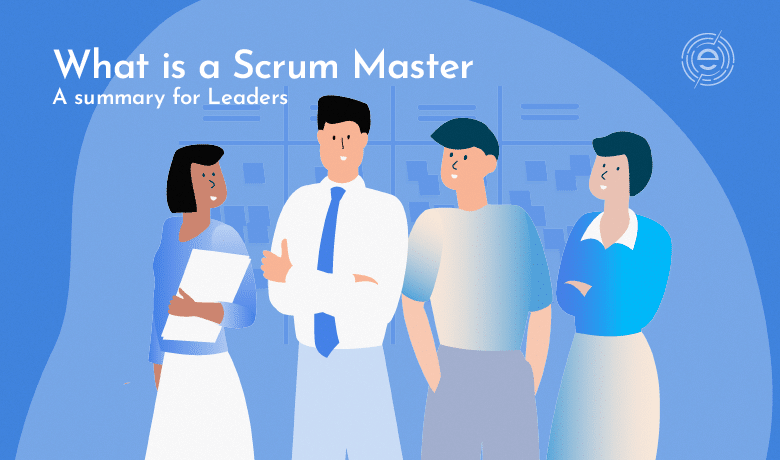What Is A Scrum Master, A Summary For Leaders

An outline of the role of the Scrum Master is given in this, before reading any further on this page, I strongly advise you to visit my in-depth article on the Scrum Methodology. It offers a succinct yet thorough introduction to the Scrum framework. Your comprehension of this technique will help you define the role of a scrum master.
If you are familiar with the basics of Scrum and want to learn more about it than only the duties, tasks, and obligations of a Scrum master, feel free to continue reading below.
A scrum team, which consists of a product owner, a development team, and the scrum master himself, is like a lighthouse. He ensures that he provides direction to his teammates in accordance with the Scrum Framework's principles.
Like a lighthouse, he makes sure to explain to everyone how to properly "port" their ship using Scrum before his crew crashes into a harbor during bad weather. Although a scrum master is a member of a scrum team, you should be aware that as the company's "scrum lighthouse," he also ensures that other employees and teams are informed about what interactions with the scrum team can be advantageous and what can be detrimental.
Scrum masters are essentially in charge of three entities: the product owner, the Development Team, and the Organization. These are merely metaphors and generalizations, but the Scrum Guide itself contains information on the precise roles, responsibilities, and duties of a Scrum master.
Before getting into the details, let's explore three broad principles of being a scrum master.
What is a Scrum Master
As a Change Agent, the Scrum Master
Scrum masters have a key position in an organization. They both feature "battlefield" perspectives and a bird's-eye view of how various teams perform on a daily basis. How?
Agile Retrospective is one of the methods. Scrum masters have the chance to identify patterns and recurrent issues in a team when they facilitate Agile Retrospective. Scrum masters at least have an understanding of what needs to happen within an organization, even though this is just the first step in igniting change.
That is where every change begins. I even prepared a detailed manual on how to use the Impediment board and Agile Retrospective to help CEOs solve problems. Scrum masters can propose important changes in an organization by taking this initiative.
Servant Leader Role of the Scrum Master
Scrum masters are referred to as Servant Leaders in the Scrum Guide. This is a crucial aspect of a scrum master because without the idea of servant leadership, a scrum master won't be able to perform to their best potential while putting the Scrum Framework into practice. It returns to the notion of a lighthouse as well.
A lighthouse's purpose is to guide travelers to secure the harbor and assist sailors.
Here is a blog post I made about the eleven qualities of a servant leader. If you're unsure of how scrum masters can serve as servant leaders in an organization, look it up.
Scrum Master as a mirror
A scrum master must act as the team's "mirror" in order to be effective. The team easily checks whether what they're doing reflects the Agile and Scrum values through a Scrum master. A team can quickly identify and be reminded of problems that go counter to the Scrum Methodology by standing in front of a mirror.
The scrum master reminds the team to fix these issues by acting as an extra set of eyes and an observer who only looks at things from the perspective of Scrum and Agile values. Members of the team can ask the scrum master open-ended questions while they are reflected in a mirror, which will help the team as a whole.
This might be accomplished by utilizing tools like metrics, sprint backlogs, and other modules. Let's return to the fundamentals and find out the primary duties of a scrum master when it comes to dealing with product owners, development teams, and the company he works for now that we have dissected three high-level tasks of a scrum master.
Scrum Master Responsibilities to Product Owner
- A scrum master must be skilled at identifying methods that are successful and effective for handling product backlogs.
- The things on the product backlogs should be clear to the scrum master.
- The scrum master must exhibit knowledge of product planning in an empirical setting.
- assistance in organizing product backlog items to maximize value
- Show off your command of agility.
- Facilitate scrum meetings as necessary.
Scrum Master Responsibilities to Development Team
- Development Team's Responsibilities as a Scrum Master
- Teach the development team how to be cross-functional and how to organize themselves
- Help the development team produce high-quality products
- Remove Obstacles to the Team's Progress
- Facilitate scrum meetings as necessary.
- Assist the development team in adjusting to a new Scrum-implementing organization
.jpg?width=1190&height=332&name=AgileMastery%20(1).jpg)
Scrum Master Responsibilities to an Organisation
- Encourage and mentor the business or organization to adopt Scrum
- Prepare the company or organization for the introduction and acceptance of Scrum.
- Ensure that stakeholders and staff understand Scrum and empirical product development.
- Changes that boost Scrum team output should be implemented.
- Working together with other scrum masters will help an organization completely implement scrum.
All of these roles and responsibilities are already discussed in this primer and also in the official Scrum Guide.
Aside from these roles and responsibilities to a scrum team, I wrote a definitive list of specific roles that a scrum master must play in the article “Scrum Master Role Everything What all Scrum Masters Need to Know”.
Keep in mind that a scrum master's primary responsibility in a firm is to assist stakeholders in adjusting to the Scrum framework and Agile Methodologies. Along with this, the scrum master should assist the business in developing a stable, self-organizing team with a defined roadmap and assist the business in identifying organizational bottlenecks.
Here are some additional Scrum Master duties that support this objective as a recap:
In charge of the Scrum artifacts
- Facilitate Planning
- Assist with refinement
- Facilitate Reviews
- Facilitate Retrospectives
- Aids the team to maintain its focus (e.g. becoming the external barrier for distractions)
- Keeps the team's scrum tools up to date (i.e. Action board, Storyboard, charts, backlogs, etc.)
- Assists the team and the product owner in defining the terms "done" and "ready"
Is in charge of fostering and developing team dynamics
- Resolution of disputes
- Advisor for the team's choices
- Supporting the developer team's efforts to self-organize
- Conflict resolution and mediation between the development team and the product owner
Sharing knowledge and learning continues with the team and the organization
- When it comes to everything Agile-related, a scrum master must have a constant learning mindset. He should feel at ease going to user groups frequently, going to conferences, reading books, writing blogs, and engaging in other activities that advance his understanding of Agile and Scrum.
- Strengthening the Agile basis of organizations by consulting teams
- Assists groups in building information radiators
- Provides the team with comments
- Especially within the development team, promote the usage of agile engineering practices.
- Encourage innovative, difficult agile management practices for teams (e.g. FedEx-Days)
- Encourage and facilitate knowledge sharing among Scrum Masters (for example through communities of practice)

Helps in Maintaining the “Big Picture” in the Team
- Encourage, facilitate, and start interactions between team members.
- Keeps stakeholders regularly informed
- Contributes to the team's report to management
- Advocates for the Scrum and Agile frameworks within the company through internal conferences and blogging.
- Become the company's go-to person for inquiries on Agile and Scrum.
How to Be a Good Scrum Master
The next obvious question would be, "How can I become a truly good scrum master now that I have some concept of the roles and responsibilities of a scrum master?
I wrote an article titled "How to be a Good Scrum Master - Starting Your Scrum Master Journey" that I highly recommend reading if you are just beginning your career as a scrum master. In this article, I described how you can systematize your first action items in the first 20 weeks in a company you work for. I can assure you that you're off to a good start if you carry this out within the first 20 weeks of your new employment.
- Start planning a private meeting with each team member. You need to be aware of their main problems regarding the team and the business at large during these sessions. You absolutely must take notes. With the help of the team's insights, you can pinpoint the issues where the agile framework can be used with ease.
- Plan a session to outline the responsibilities, expectations, and duties of each team member.
- Establish a coaching alliance as soon as possible. You are not an exception; professional coaches have this agreement in place with their clientele.
- Stakeholder mapping is a useful technique for getting to know the organization's employees.
- Place the team policies in a prominent location in the workplace or room. That acts as a visual cue for the group to maintain the fundamental working manners expected of them.
- Plan a one-day team-building workshop to instill in the team the concepts of cooperation, ethics, values, and product vision.
- In the team room, start a Kaizen board. For those that take learning and exploration seriously, this is an excellent tool.
- Create an input box for agile retrospectives. Your job will be a little easier as a result. It can be difficult to think of topics for retrospectives, so getting some topics would be a fantastic approach to generating new ideas.
- Accomplishments board. Wins are frequently overlooked, especially in a professional setting. The crew will be inspired to work harder by seeing their accomplishments displayed on a wall.
- Thanks, wall. It's an ostensibly straightforward yet powerful technique for showing how individuals value, care for, and care about one another.
- The Organizational Impediment Board should be set. Consider all the organizational barriers present in the business. This will assist in preparing everyone's minds to deal with these obstacles.
- Launch a learning wall. Any organization ought to be designed with learning in mind. A useful tool for promoting a learning attitude in the workplace is a learning wall.
- Groups of practitioners, Communities of practice are a crucial framework for enhancing the learning environment in your business, speaking of which.
- Plan product development flow and principles workshops.
- Start a release planning process that enables the team to look beyond sprints and at the organization as a whole.
- To assist in expressing expectations to other stakeholders, teach and train product owner how to create a release forecast.
- Plan workshops on causal loop diagrams, system thinking, impact mapping, and story mapping.
- Create a pair programming matrix board and begin practicing pair programming.
Scrum Master Required Skills and Experience
According to me, a qualified scrum master has the following qualities:
- At least one year of experience playing the position of Scrum Master in a team developing software with a focus on Scrum's guiding principles, frameworks, theory, and practices.
- Situational awareness, servant leadership, empowerment, facilitation, dispute resolution, ongoing improvement, and greater transparency are examples of soft skills.
- Understanding of well-documented patterns and methods for filling in the gaps in the Scrum methodology, such as Burndown technologies, bug handling, multiple Retrospective formats, etc.
Preferred Skills and Experiences (Any of these is a plus)
- Experience working as a Scrum Master for a software development team that had been consciously applying Scrum's tenets for two years.
- Existing expertise in other Agile methodologies, such as XP, Crystal, Kanban, FDD, etc.
- Some familiarity with and practical knowledge of well-known and effective Agile practices like User Stories, TDD, Continuous Integration, ATDD, Continuous Testing, Automated Testing, Pairing, and Agile Games.
- Understanding of and practical familiarity with the team's chosen technology.
- Experience filling in the gaps in the Scrum process using well-documented patterns and techniques (for example various many Retrospective formats, Burndown technologies, handling bugs, etc.).
- Abilities in mentoring and communication
- Experience in the development of general-purpose software. It is not advised to select a certain position.
- Other items a scrum master may deem important, pertinent, and related to the project, team, business, and team culture.
How to Interview a Scrum Master
In a blog post entitled Scrum Master Interview Questions, I shared my personal experience in getting interviewed for a scrum master position. It was a fantastic 2-hour experience for me since I was able to learn a lot not only in terms of the general practice of scrum and also about the type of people I would be working with.
They checked my blog and books, which is uncommon for many businesses. It came as a welcome surprise. The role-playing they started during the interview was another thing that I really loved.
I must admit that it was an excellent technique to determine a candidate's viewpoint and how a candidate may respond to certain events.
I strongly advise using role-playing interviews when hiring scrum masters to see whether candidates have the experience, soft skills, and other qualifications you need. Don't forget to read the blog post to see some interview questions you may use with candidates.
How and Where to Find an Awesome Scrum Master
It's like trying to find a needle in a haystack, is the quick and straightforward response to this. The reality is that most members of the Agile community make fun of the idea of a scrum master. They believe it to be organizational redundancy. They oversimplify the role to the point where it violates the tenets of the Scrum framework.
The fact that just a few scrum masters are able to completely realize the potential of the Scrum Framework is one of the causes, in my opinion. Another factor is the dearth of industry role models who might effectively convey the benefits and strength of having a scrum master.
Last but not least, organizations frequently forget to credit the scrum master for the achievements they achieve. In this paper, I carefully argued my position regarding these feelings.
You should read it to properly grasp how difficult it would be to locate a trustworthy scrum master in a world where so few people have truly appreciated and understood its full value to an organization.
Did you like this article?
Are you looking to build an Agile Company? We can help you with this task in different ways. You can start by taking a look at our Agile Training and Agile Consulting pages.
One of our most popular services is our Agile Executive Workshop, a 2,5 days workshop to help leaders to identify what are the exact steps they need to take in order to build a great Agile Company.
In case you are looking to get external support with an external Scrum Master check out our Scrum Master Consulting program, a 6-months program to transform your Scrum Teams.
If you are sure that you want to do a full Agile Transformation, then our Enterprise Agility Program is the right approach for you, a complete package to transform your company into an Agile, Flexible, and Fast Digital Product company.



.png?width=1190&height=332&name=How-to-Design-Product-Organisation-AM%20(1).png)


